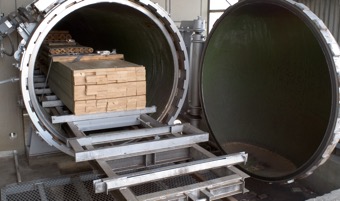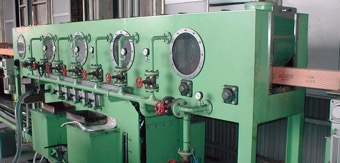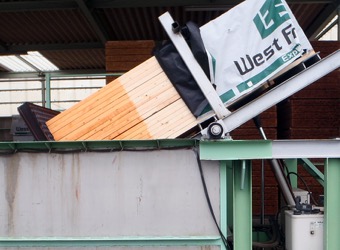Wood Preservation
- TOP
- Wood Preservatives / Termite Control
- Wood Preservation
Wood Preservation
Types/characteristics of wood preservatives
Wood preservation is technology used to extend the durability of wood by permeating the interior of wood with preservatives, thereby delaying deterioration caused by rotting or by termites. Treatment methods include pressure injection, deep penetration, and surface treatments such as dip, coating, or spraying, which are selected considering use or purpose. Of these, deep penetration, a proprietary method of Xyence, is a revolutionary new process that ensures performance identical to that of pressure injection “AQ2 class (equivalent to JAS K3)” but without changing dimensions of the wood.
Types of preservative agents
| Products | Tanalith® CY |
Pentacua New BM |
Pentacua ECO30 |
Sanpreser OP Ace |
Sanpreser OP-C |
Sanpreser PW96 |
|
|---|---|---|---|---|---|---|---|
| Categorization of wood preservatives | Water based | Water based | Water based | Oil based | Oil based | Emulsifiable concentrate | |
| Colors of chemical agents and treated materials | Blue-green chemical agents, treated wood is moss green. | Transparent liquid, treated wood is uncolored. *Xyence also has color treated products to distinguish them from untreated wood. | Transparent liquid, treated wood is uncolored. | Transparent liquid, treated wood is uncolored. | Transparent liquid, treated wood is uncolored. | Milky white agents (agents thinned with water), treated wood is uncolored. | |
| Characteristics | This is a reliable chemical agent made by adding an anti-rot agent to an antimicrobial copper compound. | DDAC made from palm oil is effective against mold spores. | In addition to palm oil DDAC, a chemical agent with strengthened anti-rot and anti-termite agents, it is counted on to be effective even when used on outdoor facilities. | This is an environmentally friendly chemical agent effective against rot and termites at low concentrations. | This is an environmentally friendly chemical agent effective against rot and termites at low concentrations. | This is an environmentally friendly chemical agent effective against rot and termites and against mold spores at low concentrations. | |
| Active ingredients |
Copper Compounds Cyproconazole |
DDAC(didecyl dimethyl ammonium chloride) |
DDAC(didecyl dimethyl ammonium chloride) Tebuconazole Imidacloprid |
Cyproconazole Bifenthrin |
Cyproconazole Etofenprox |
Tebuconazole Etofenprox IPBC(Iodopropynyl Butylcarbamate) |
|
| Use | House foundations | 〇 | 〇 | 〇 | |||
| General building materials | 〇 | 〇 | 〇 | 〇 | 〇 | 〇 | |
| Park facilities | 〇 | 〇 | 〇 | ||||
| General civil engineering materials | 〇 | 〇 | |||||
| JWPA Japan Wood Protection Association(JWPA) Certificate No. |
A-5324 | A-5056 | A-5325 | A-5457 | A-5307 | A-5295 | |
| Japanese Industrial Standard(JIS) K 1570 “Wood Preservatives” | 〇 | 〇 | 〇 | - | - | - | |
| Japanese Industrial Standard(JIS) K 1570 “Wood preservatives – Performance requirements and their test methods for determining effectiveness” | 〇 | 〇 | 〇 | 〇 | - | 〇 | |
| Japanese Agricultural Standard(JAS) Preservation treatment / chemical agents | 〇 | 〇 | 〇 | - | - | - | |
| Approved Quality of Wooden Building Materials(AQ) Chemical agents | 〇 | 〇 | 〇 | 〇 | - | - | |
| Method of Processing | <Pressure injection Treatment> | <Deeper Penetration Treatment> | <Surface Treatment> | <Dip Treatment> | |||
| Safety | After wood is treated and cured, the principal constituents do not dissolve even if the wood is dampened by rain, etc. Chlorpyrifos, a material prohibited by the Building Standards Law, is not used. Hazardous substances including hexavalent chromium and arsenic are also not used. And the amount of diffused formaldehyde, which is restricted under sick house syndrome prevention regulations, which emanates from treated wood and untreated wood is equal. | ||||||
| Disposal Method | Since Xyence does not use hazardous substances, please dispose of our products appropriately as normal waste (in the case of business facilities, as industrial waste). | ||||||
Pressure injection treatment

The wood is placed inside a chemical injection can, then the pressure inside the can is reduced, discharging air from inside the wood, and finally wood preservative (chemical) filling the can is caused to deeply penetrate (injected into) the wood by applying high pressure. According to use, one of three types of preservative, Tanalith ®CY, Pentacua ECO30, and Pentacua New BM, is selected.
Deep penetration Treatment

A proprietary technology of Xyence, it is performing by using a full-surface super-jet device to spray and permeate incised wood with wood preservative. The treated material is extremely dimensionally stable at the same time as can be given preservative quality of AQ2 class (equivalent to K3), which assures preservation performance equal to that of pressure injection. The preservative agents used are Sanpreser OP-C or Sanpreser OP Ace. The two agents are handled similarly under the work specifications of the Japan Housing Finance Agency and under the Housing Quality Assurance Law, and may be used at the same time.
Dip treatment (factory treatment)

The wood is immersed in a tank (dip tank) filled with wood preservative (chemical) so that the wood preservative adheres to the wood surface. It is a treatment by a method controlled in a factory, so it provides quality superior to that of treatment on work sites which are subjected to the effects of the weather. A merit of this method is that decay prevention or termite damage prevention of members to a height 1m above the ground surface stipulated in the Housing Quality Assurance Act can be done in advance in a factory.
